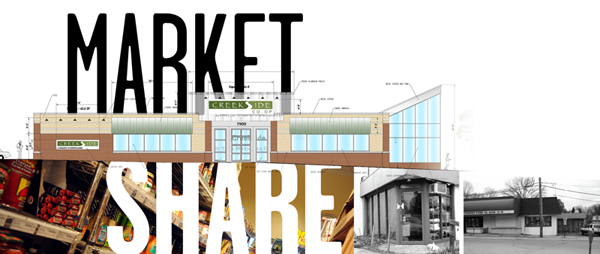 story by Tara Mataraza DesmondFrom the early ’60s through the late ’90s, the Elkins Park business district was an active town center—and Ashbourne Market its de facto town hall. The market eventually occupied a good percentage of the sidewalk-framed storefronts along the main strip, as the owners bought up other businesses to increase space. Technically, it was a grocery store, but it was also a gourmet magnet. The place was Philadelphia’s equivalent to New York City’s Zabar’s: If a culinary trend popped up—truffles, caviar, dried chiles—Ashbourne carried it. People would travel from all over to shop there. And, for Elkins Park residents, it became more than just a place to sample the legendary whitefish salad—it was a meeting place.
story by Tara Mataraza DesmondFrom the early ’60s through the late ’90s, the Elkins Park business district was an active town center—and Ashbourne Market its de facto town hall. The market eventually occupied a good percentage of the sidewalk-framed storefronts along the main strip, as the owners bought up other businesses to increase space. Technically, it was a grocery store, but it was also a gourmet magnet. The place was Philadelphia’s equivalent to New York City’s Zabar’s: If a culinary trend popped up—truffles, caviar, dried chiles—Ashbourne carried it. People would travel from all over to shop there. And, for Elkins Park residents, it became more than just a place to sample the legendary whitefish salad—it was a meeting place.
Unfortunately, as competition from major chains moved in—including Whole Foods, Trader Joe’s, Acme and Genuardi’s—Ashbourne wilted and eventually folded in 2002. Several businesses came and went in the market’s old space, but none lasted. Today, when you hop off the train at the Elkins Park SEPTA station, the view has changed. A once-bustling downtown district has become relatively desolate, with only a few storefronts and a coffee shop still doing business.
Elkins Park is six miles from Center City and one of the first suburbs over the northwest city line. The close proximity makes for an easy commute for Philadelphia workers, and fuels the diversity of the borough. With memories of Ashbourne’s heyday still fresh in their minds, locals decided that a grocery store would be key to the town center’s reignition. This time, the neighbors decided to do it themselves, investing in a food cooperative (co-op), a member-owned grocery retail store.
Since December 2007, Elkins Park residents have been working to make that vision a reality. The cooperative is evolving simultaneously with a mainstream shift in thinking from selfhood to solidarity, from mega-mart to buy local, from gratuitous grocery gratification to the search for a sense of place on our dinner plates. Creekside Co-op, as it’s been named, is the story of how a new business is emerging to revive an old way of life, and helping a neighborhood look to the future.
Food cooperatives are centuries old, rooted in the development of industry, when people began leaving rural areas in droves to live and work in cities. They were markets that connected farmers and their goods, at a fair price, to urban dwellers who had limited access to farm fresh products. Today, there are about 300 food cooperatives in the United States, in both rural and urban areas. While traditional grocery stores and supermarkets are built to turn a profit, cooperatives exist because of the investment of their members, who commit to both working and shopping to sustain the business. Decision-making power, governance and profits all fall squarely in the shopping carts of the clientele.
There are seven internationally recognized cooperative principles: voluntary and open membership; democratic member control; member economic participation; autonomy and independence; education, training and information; cooperation among cooperatives; and concern for community. The board members, general manager and members all commit to upholding these principles.
Food cooperatives tend to internalize an obligation to the welfare of surrounding communities and the broader environment. Profits are often endowed to neighborhood and regional programs and organizations to support sturdy communities. Most co-ops make distribution of natural, organic and locally-produced products a priority. In America, the West Coast is rich with established food cooperatives spurred by the ’60s and ’70s counterculture. Natural and organic food activists wanted control over what they were eating. Today, that demand has gone mainstream.
In December of 2007, Elkins Park community members wanted to gauge the enthusiasm for the idea of bringing a food co-op to town. They rented space at the Elkins Park Free Library and set up 30 chairs. More than 200 neighbors showed up.
“We didn’t have to convince anyone that this was a good idea,” says Andrew Schloss, a founding member and lifelong resident of the community. He and several others formed an ad hoc board of directors to put things in motion. Today, 1,280 households have joined (equating close to 3,600 members), and the doors aren’t even open yet. Members have the option to invest $50 per year, capping out at $400 after eight years, or to become fully vested with a one-time $400 advance contribution. “The business plan we are building off of now is what we aimed at for the second year of operation,” explains Schloss. The co-op has also applied and qualified for a USDA loan, and is tying up loose ends on loans from local banks.
Members settled on the name “Creekside” based on the nearby Tookany Creek, which runs through Elkins Park and provided an artery for settlers and entrepreneurs to build a viable community during the industrialization of Philadelphia. That creek symbolizes growth. The Creekside Co-op, says Schloss, is “about regeneration of a community that’s hungry for a town center. The town has felt somewhat devastated without one.”
The board members weighed in on three different locations during the site evaluation process. One had a parking lot and was in a visually prominent spot along a major thoroughfare. Another was predicted to be the most profitable, in the shortest amount of time. But the Ashbourne Market location, at the foot of the SEPTA train stop, meant revitalization. “We asked ourselves if we wanted to regenerate Elkins Park or be as rich as possible,” says Schloss. “We decided we wanted to regenerate our community.”
Cooperatives put the steering wheel in the hands of a general manager who is tasked with upholding the principles and bylaws. Ryan Youngman was hired as the Creekside CEO and General Manager. He is a third generation grocer, and regards the grocery business as a reliable opportunity. “Everybody’s got to eat,” he says.
Youngman is passionate about natural foods and organics—and his career grew in that direction. He worked for several natural food grocers and eventually started his own distributor, Good Earth, Inc., which he sold to United Natural Foods, Inc., the nation’s largest natural foods wholesaler. Youngman worked with Whole Foods Market as a regional director to establish Pacific Northwest stores. He was eventually recruited away from his hometown of Seattle to Richmond, VA, to run Ellwood Thompson’s Local Organic Market and be its CEO. Creekside is his first venture into food cooperatives.
“Creekside is about community resurgence, and nothing builds community more than a neighborhood grocery store,” says Youngman. He points out that 70 cents of every dollar spent at a locally-owned business stays in the community.
Youngman foresees carrying both organic and conventional products, based on demand from customers. “The decision-makers are in the stores, not in a corner office in some other city,” he explains. He is also determined to source seasonally and locally. “Farm-to-fork ideology needs to stay,” he says. “We want farmers to be able to sell direct to the market.”
Creekside will tap into other local businesses, including restaurants, for product partnerships and will leverage buying power with national distributors of organic and natural foods, like United Natural Foods, Inc., and the National Cooperative Grocers Association.
Youngman intends to offer products of high value—items that are both delicious and nutritious. “Big conglomerates have homogenized the value of a grocery store to a community and the definition of value has changed,” he says.
Youngman also wants Creekside to be a place where people can gather to talk, exchange ideas and connect with one another. “Grocery stores are the church of a community,” he says. If the store is the church, then Youngman is indeed the pastor, ready to congregate neighbors around co-op principles, and excited to spread the word of natural, organic and locally-sourced food.
Elkins Park residents had an ideal model to reference when brainstorming for their own food cooperative. Weaver’s Way Co-op in Philadelphia’s Mt. Airy neighborhood is nationally recognized for its success and community impact. Organized in 1973, Weaver’s Way is busting at the seams with 3,600 families as active members. They did $8.7 million in business last year, and are set to open a second location in Chestnut Hill in 2010, lifting some pressure off the current store.
Weaver’s Way has been integral to Creekside’s development. In fact, Weaver’s Way general manager Glenn Bergman was at the Elkins Park library in 2007, on the night of that very first gathering. Before Chestnut Hill was finalized, Weaver’s Way was considering Elkins Park for its second location.
Bergman stayed connected with Creekside as a member-at-large in an effort to uphold the seventh principle of cooperatives: “cooperation amongst cooperatives.” “They are an amazing community, working together to reignite the downtown,” says Bergman of Creekside. “They are going to be incredibly successful.”
Weaver’s Way remains a paragon of success for burgeoning cooperatives. Its loyal membership investments, which have kept the business going for over 30 years, pay returns not only to members, but also to the surrounding neighborhood. “We believe so much in the power of community doing something good,” says Bergman.
Weaver’s Way’s impact expands well beyond the shelves of the tiny Mt. Airy storefront. They’ve created a small farm in the city’s Awbury Arboretum that supplies the co-op with hyper-local seasonal produce. They also farm a small parcel of Fairmount Park land in conjunction with W.B. Saul High School, offering a CSA to the surrounding neighborhoods. And they have designed mini-cooperatives at local schools that sell garden and farm products. “Any profit goes back to the members or stays in the community,” explains Bergman. Weaver’s Way has also invested in other co-ops, loaning money at interest, twice in the last five years.
“People like to support companies that honor the triple bottom line: people, planet and profit,” says Bergman. Employees of co-ops (including Weaver’s Way and Creekside, when it gets underway) earn a living wage, one that’s higher than pay from a traditional grocery store.
The positive impact a successful cooperative like Weaver’s Way makes on a neighborhood is exactly what drove Lena Helen to pursue creating one in Kensington. The Kensington Community Food Cooperative (KCFC) has been in the works since summer of 2008, and is currently in the early stages of feasibility studies and site evaluation.
KCFC’s mission is to serve as a grocery store in the Kensington area that will provide healthy, quality food, products and services to its members and the community. It will also be committed to the environment and to supporting local and organic farming. “Knowing what a cooperative can give to the community drives me,” says Helen of her efforts to breathe life into KCFC. “We went to visit Weaver’s Way and said, ‘We need this!’”
Helen and fellow KCFC founding members pushed for a cooperative instead of a traditional grocery store because of a co-op’s mission to educate members about food, ethics and health. “Food is the bottom line for everyone,” says Helen. “It’s what makes a healthy community and healthy individuals.” KCFC is aiming for a spring 2011 opening.
The same vision of a vibrant community spurred the idea of the Creekside Co-op. Jennifer Brandabur, a Creekside member, has been involved in the planning from the start. She saw the need for a cooperative when it was clear that neighbors were no longer shopping in downtown stores and were not vested in the neighborhood.
Since the 2007 meeting, Brandabur has played the role of fundraiser, grant writer and cheerleader—she is also a newly elected board member. “One of the things I find so appealing about the co-op is that it can provide our community with a central meeting place that is open to everyone,” she says.
Over the last two years, Brandabur has become acquainted with people who share those values. “It’s been tremendous to see the pool of talent available and the amount of time people are willing to dedicate to help their community,” she says.
As the projected late springtime opening approaches, Youngman and the board, including Schloss and Brandabur, are in the process of choosing the product inventory that will define them as a cooperative and distinguish them from the competition. There’s a lot of talk about “value judgments”—decisions made about products based on the cooperative philosophy and any additional indicators gleaned from member surveys and feedback. “There is an inference that you’ll be taken care of as a co-op member, by virtue of the operating principles of cooperatives,” explains Youngman. “It’s not just a service, it’s believing in the value.”
“The reason you set a philosophy is you want to take care of a lot of the choices for customers,” says Schloss. If members trust the decisions made by the general manager and the board, they feel relieved of the pressure to read every single label or research on their own time because the legwork has already been done.
Brandabur adds, “We have a commitment to sourcing our products as responsibly as possible.” In the instances where co-op products or services are more expensive than options at a nearby supermarket, the co-op staff is tasked with educating members and changing the perceived value.
Youngman intends to hire employees who are knowledgeable about products and sustainability issues so they can offer contextually relevant input to shoppers. This might include stressing the economic impact of buying locally, or explaining the environmental benefits of choosing organic over conventional produce. It could mean handing out samples of a chocolate sandwich cookie void of hydrogenated oils and high-fructose corn syrup as a suggested alternative to “America’s favorite cookie.”
The proposed 7,800 square feet of Creekside’s retail space is being designed to serve as a one-stop-shop tailored to the requests of its members. The full-service grocery store will include a prepared foods section, a hot bar, soups, sushi and charcuterie. Youngman and the board hope that the choices they make on behalf of investors will help shoppers feel good about their purchases, and will distinguish the co-op from competing groceries. They even plan to stock the original-recipe Ashbourne Market whitefish salad—the legend that lured Elkins Park neighbors for so many years. ■
Mariposa To Expand
Another Philadelphia co-op is also on the move. Mariposa, in West Philadelphia, is close to securing a deal to purchase a space just a block from their current home at 4726 Baltimore Ave. The new building will have five times the space of the original location. Mariposa has been working with the Community Design Collaborative to incorporate green elements into the space which will feature more room to process and prepare food, a loading dock and space for overstock. “With a new larger space we will be able to further our mission,” says store manager Bull Gervasi, “We’ll provide more residents of West Philly with healthy, affordable, locally grown and sustainably produced food while also supporting more local farmers and offering more people meaningful employment.” For information on the Mariposa expansion, visit mariposa.coop.





natural products stores must exist…People are going more to them than to the supermarket